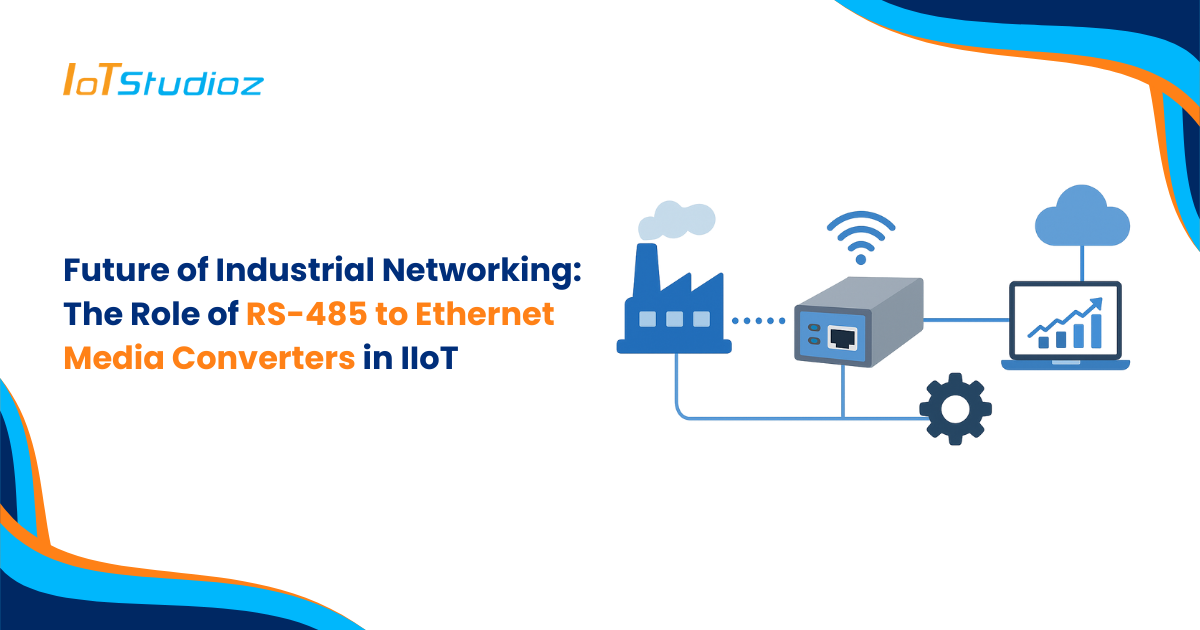Future of Industrial Networking: The Role of RS-485 to Ethernet Media Converters in IIoT
Industrial networking has evolved dramatically in recent years, driven by the rise of the Industrial Internet of Things (IIoT). The shift towards smart factories, predictive maintenance, and real-time data monitoring requires seamless communication between legacy systems and modern IP-based networks. One of the most critical technologies enabling this transformation is the RS-485 to Ethernet Media Converter.
By bridging traditional serial communication protocols with modern Ethernet infrastructure, these converters play a pivotal role in extending the life of legacy devices, improving connectivity, and ensuring smooth integration into IIoT ecosystems.
- Over 70% of industrial equipment still relies on serial communication protocols like RS-485.
- The global IIoT market is projected to reach $1.7 trillion by 2030, making integration solutions critical.
- Adoption of Ethernet-based industrial networking is growing at 20% CAGR, but legacy systems continue to dominate plant floors.
Understanding RS-485 and Its Relevance Today
RS-485 is a robust and widely used serial communication standard, particularly suited for industrial environments. It supports:
- Long-distance communication (up to 1,200 meters).
- Multi-drop networks (connecting multiple devices on the same bus).
- Noise immunity, essential in electrically noisy industrial settings.
Despite its strengths, RS-485 was not designed for cloud connectivity, remote monitoring, or integration with modern Ethernet-based networks. This limitation has given rise to RS-485 to Ethernet Media Converters, which act as translators between two worlds: legacy serial communication and modern IP-based data exchange.
Why RS-485 to Ethernet Media Converters Are Essential in IIoT
The IIoT vision requires that every machine, sensor, and device can communicate seamlessly. RS-485 to Ethernet converters enable this by:
- Connecting legacy devices to modern networks: Older PLCs, sensors, and controllers using RS-485 can be integrated into Ethernet networks without hardware replacement.
- Extending device life: Instead of replacing expensive legacy systems, converters allow them to stay operational in IIoT frameworks.
- Supporting real-time monitoring: Data from RS-485 devices can be transmitted to cloud platforms or SCADA systems via Ethernet for instant analysis.
- Improving scalability: Ethernet makes it easier to expand networks and add more devices without extensive rewiring.
Applications in Industrial Networking
RS-485 to Ethernet Media Converters have become indispensable in multiple industrial applications:
- Smart Factories: Connecting CNC machines, robotic arms, and programmable logic controllers (PLCs) to centralized monitoring systems.
- Building Automation: Integrating HVAC systems, lighting, and access control that often use RS-485 protocols like Modbus RTU into IP networks.
- Energy and Utilities: Enabling smart meters, grid monitoring equipment, and renewable energy systems to share data over Ethernet.
- Transportation Systems: Linking RS-485-based railway signaling equipment and traffic control devices to centralized Ethernet-based control systems.
- Oil and Gas Industry: Facilitating remote monitoring of drilling equipment, pumps, and sensors in hazardous environments.
Benefits of RS-485 to Ethernet Media Converters in IIoT
- Seamless Protocol Conversion: Many converters support Modbus RTU to Modbus TCP/IP conversion.
- Reduced Downtime: Enables centralized diagnostics and maintenance.
- Cost-Effectiveness: Eliminates the need for replacing functioning legacy systems.
- Security Enhancements: Modern converters include encryption and firewall features for safe data transmission.
- Future-Proofing Networks: Facilitates gradual migration from serial to fully Ethernet-based infrastructures.
Future Outlook: The Growing Role in IIoT
As industries move toward Industry 4.0, the demand for hybrid networks that combine legacy and modern devices will only grow. RS-485 to Ethernet converters will remain crucial in this transition phase, ensuring:
- Edge computing integration: RS-485 data can be processed at the edge before being transmitted to the cloud.
- Cloud connectivity: Devices that once had no internet capability can now be integrated into IoT dashboards.
- AI-driven analytics: Data collected through converters can be fed into machine learning models for predictive maintenance and optimization.
- Scalable IIoT ecosystems: Supporting massive device networks across factories, plants, and global operations.
Conclusion
The RS-485 to Ethernet Media Converter is more than just a connectivity device—it is a bridge to the future of industrial networking. By enabling legacy devices to communicate in Ethernet and IIoT ecosystems, these converters ensure cost efficiency, reliability, and long-term scalability.
As industries continue to embrace digital transformation, the role of RS-485 to Ethernet converters will only expand, making them indispensable tools for any business looking to future-proof its industrial networks.
FAQs
Q1. What is the main purpose of an RS-485 to Ethernet Media Converter?
It allows devices using RS-485 serial communication to connect and communicate over modern Ethernet networks.
Q2. Can RS-485 to Ethernet converters support Modbus communication?
Yes, many converters support protocol translation between Modbus RTU (RS-485) and Modbus TCP/IP (Ethernet).
Q3. Are RS-485 to Ethernet converters suitable for IIoT applications?
Absolutely. They enable legacy devices to transmit data to cloud platforms, SCADA systems, and analytics tools.
Q4. Do these converters improve network security?
Modern converters come with features like password protection, encryption, and firewall options to secure industrial networks.
Q5. Is it better to replace legacy RS-485 devices instead of using converters?
Not necessarily. Converters provide a cost-effective way to extend the life of legacy systems while still integrating with IIoT.

